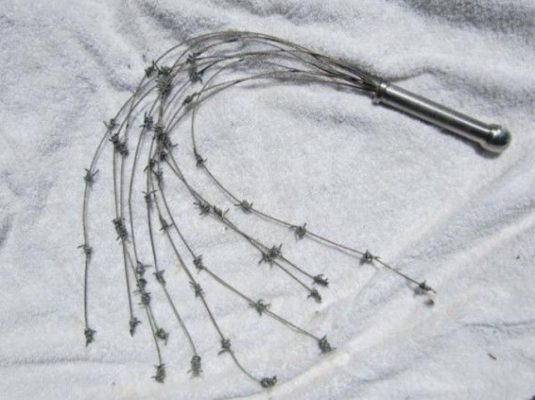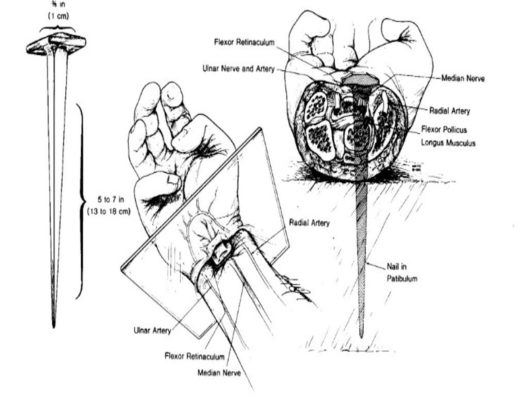Medical Description of the Flogging and Crucifixion of Jesus
Remember, Jesus had just finished a full Passover meal; our equivalent would be a Thanksgiving meal. He then went to the garden of Gethsemane and prayed all night. Since He knew the amount of suffering that He was about to endure, it is sufficient to say that He was experiencing a great deal of psychological stress (Luke 22:44). Sweating blood is called hematidrosis. It’s when severe anxiety causes the release of chemicals that break down the capillaries in the sweat glands, and the sweat comes out tinged with blood. This also makes the skin around where this is happening very fragile and sensitive. Jesus was arrested and taken to Annas where He was hit in the face (John 18:22). He was then taken to Caiaphas and beaten again (Mark 14:64,65). He was taken to Pilate, Herod and back to Pilate again where He was flogged (whipped).
A Roman whip isn’t like the western whip that we’re used to. The Roman cat-o-9 tails was several whips tied together at the handle. Each individual braided leather whip had pieces of metal and sharp bones ‘glued’ onto the ends of it. When the whips would strike the flesh, instead of leaving a nice, clean laceration they would dig into the flesh and stay. The flogger would then have to pull the whips out, which tore chunks of flesh off with it. The whip lashes that you normally think of are not what is produced here. Whole sections of flesh are torn off. After several blows, the back would be so shredded that parts of the spine may be exposed. The lacerations would tear into the underlying skeletal muscles and produce quivering ribbons of bleeding flesh…
The sufferer’s veins were laid bare, and the very muscles, sinews, and bowels of the victim were open to exposure. The whippings go from the shoulders, down the back, the buttocks and to the upper part of the legs. Roman floggings usually consisted of 39 lashes but frequently were a lot more, depending on the mood of the soldier doing it. Many people died
from this kind of beating even before they were crucified. At the very least, the person would experience tremendous pain and go into hypovolemic shock.
Hypovolemic shock does four things to a person:
1. the heart races to try to pump blood that isn’t there
2. the blood pressure drops, causing fainting or collapse
3. the kidneys stop producing urine to maintain what volume is left
4. the person becomes very thirsty as the body craves fluids to replace the lost blood volume
Jesus was in hypovolemic shock. Notice that when He was carrying His own cross, He collapsed and had to have it carried for Him (Luke 23:26). Also He said “I thirst” (John 19:28). Because of the terrible effects of this beating, Jesus was already in critical condition even before He was crucified. He probably didn’t have much ‘skin’ left on His back when they were done with the flogging.
But remember, after this flogging, He was beaten again (a third time). See Mark 15:16-20. The purple robe that they put on him would have started to congeal to His body because of the blood. After beating Him with their fists and a rod, they ripped off the purple robe (tearing away the congealed blood) and put his own robe on Him.
Judean thorns were anywhere from 2″-5″ long. They would have cut through the skin on His head (these were much bigger and stronger than the rose-bush thorns that we’re used to seeing). They couldn’t just set this crown of thorns on His head; they had to beat it on with a rod to make the thorns stick into His flesh…
He then carries His own cross up the Via De La Rosa, the path that lead to where He was to be crucified. This path has a relatively steep incline to it, making it even harder to climb. Roman crosses were very heavy (up to 200 pounds) and were made of rough-hewn lumber. While He was carrying it, some of the wood splinters probably pierced His already bloody back…
The Romans used spikes that were 5 to 7 inches long and were tapered to a fine point. They were usually driven through the wrist, not the hand. The wrist was considered part of the hand in Roman times. If the spikes were driven through His palms, His weight on the cross would have caused the skin to tear and He would have fallen off of the cross. A spike through the wrist would have hit and crushed the median nerve. This type of pain was so beyond description that a new word was invented to describe it – excrutiating – which literally means ‘out of the cross’.
Think of it like this: Do you know the kind of pain that you feel when you hit your elbow’s funny bone (which is actually hitting a nerve)? Take a pair of pliers, squeeze and crush that
nerve. That’s the kind of pain Jesus was feeling in His arms, all the time. The same thing would be true for the nerves in His feet. Having been lifted up on the cross, His arms would
have been stretched about 6′ in length and both shoulders would have become dislocated.
As the arms fatigue, great waves of cramps sweep across the muscles, knotting them in deep, relentless, throbbing pain. Hanging by His arms, the pectoral muscles become
paralyzed and the intercostal muscles are unable to act…

Crucifixion is death by asphyxiation. In order to exhale, Jesus had to push up on His feet so the tension on His diaphragm muscles would be eased for a moment. But, by doing this, His foot pushed through the spike, locking up against the tarsal bone, creating incredible amounts of pain. Also, He was scrapping His bloodied back against the coarse wood of the cross. After exhaling, He was able to relax and take another breath in. But again, He’d have to push Himself up to exhale. All of this just for one breath. This would go on until the person wasn’t able to push up to breathe anymore…
As Jesus slows down His breathing, He goes into respiratory acidosis. The carbon dioxide in His blood is dissolved into carbonic acid, causing the acidity of His blood to rise. This leads to an irregular heartbeat. In addition to that, the hypovolemic shock would have caused an increased heart rate that contributed to heart failure resulting in pericardial effusion (fluid around the heart) as well as pleural effusion (fluid in the lungs). It is almost over now…
The loss of tissue fluid has reached a critical level; the compressed heart is struggling to pump heavy, thick, sluggish blood into the tissues, and the tortured lungs are making a frantic effort to gasp in small gulps of air, while the markedly dehydrated tissues send their flood of stimuli to the brain. Once feeling in the legs was gone, Jesus would be unable to push up in order to breathe and death would occur quickly…
When the Roman soldier’s spear went through His side (John 19: 34), blood and water came out This is exactly what would happen if the spear ruptured the heart. The blood and ‘water’
would be separated because of pericardial effusion.
Medically speaking, there is no doubt… Jesus was dead!
Articles on the death of Jesus Christ:
The articles on the death of Jesus Christ are too numerous to quote but here are a few:
- ‘The crucifixion of Jesus: the passion of Christ from a medical point of view’
Arizona Medicine, vol.22 no.3 (March 1965), pages 183-187 - ‘On the physical death of Jesus Christ’
Journal of the American Medical Association, (March 21, 1986), pages 1455-1463 - ‘Crucifixion in the ancient world’
Philadelphia, Fortress Press, 1977 - ‘How Jesus died: The final 18 hours’
a video released by Trinity Pictures,
Dr. Ramsay MacMullen, Emeritus Professor of History at Yale University
Dr. James Strange, Professor of Religious Studies at University of Southern Florida
Dr. Frederick Zugibe, Medical Examiner - ‘The Resurrection Factor’
Josh McDowell, San Bernardino, California, Here’s Life Press, 1981In His Name,
Dave Maynard
https://bsssb-llc.com










